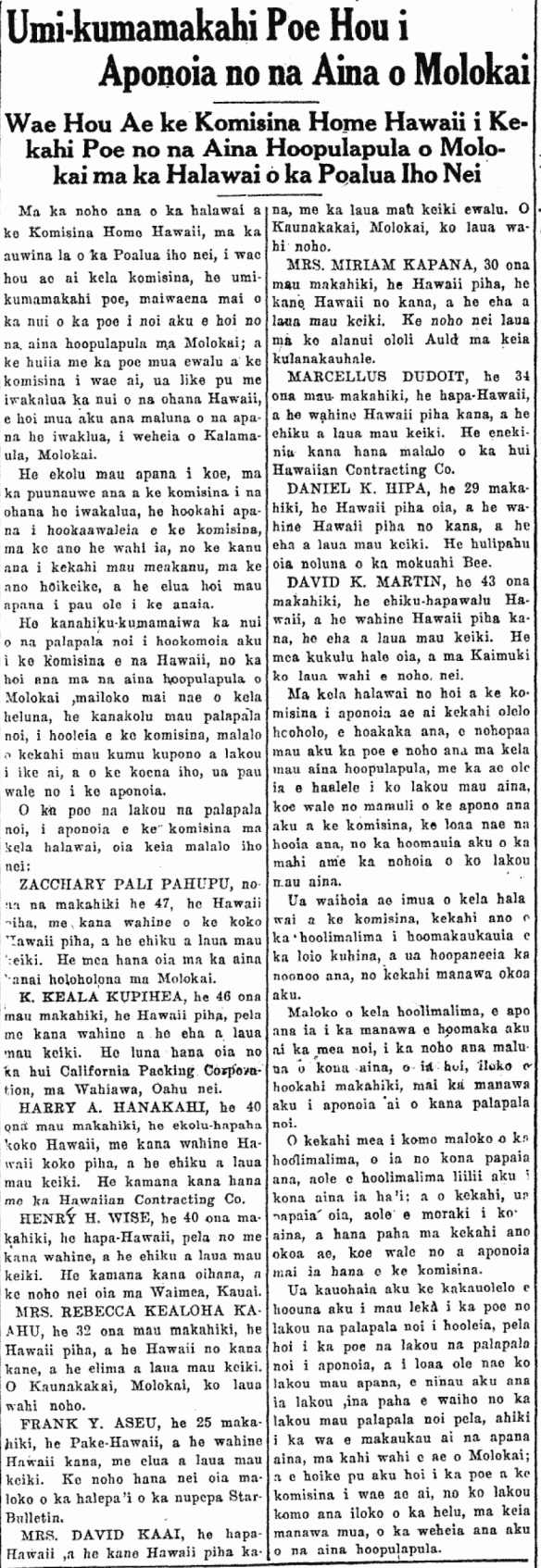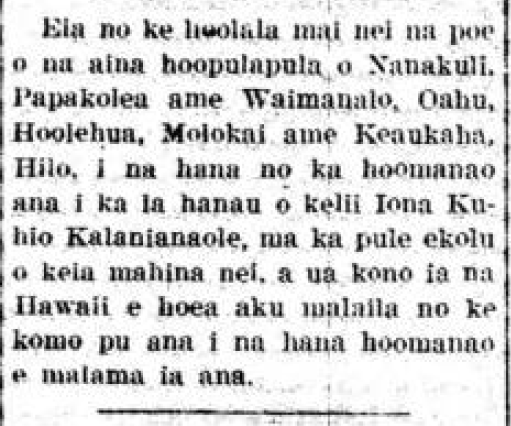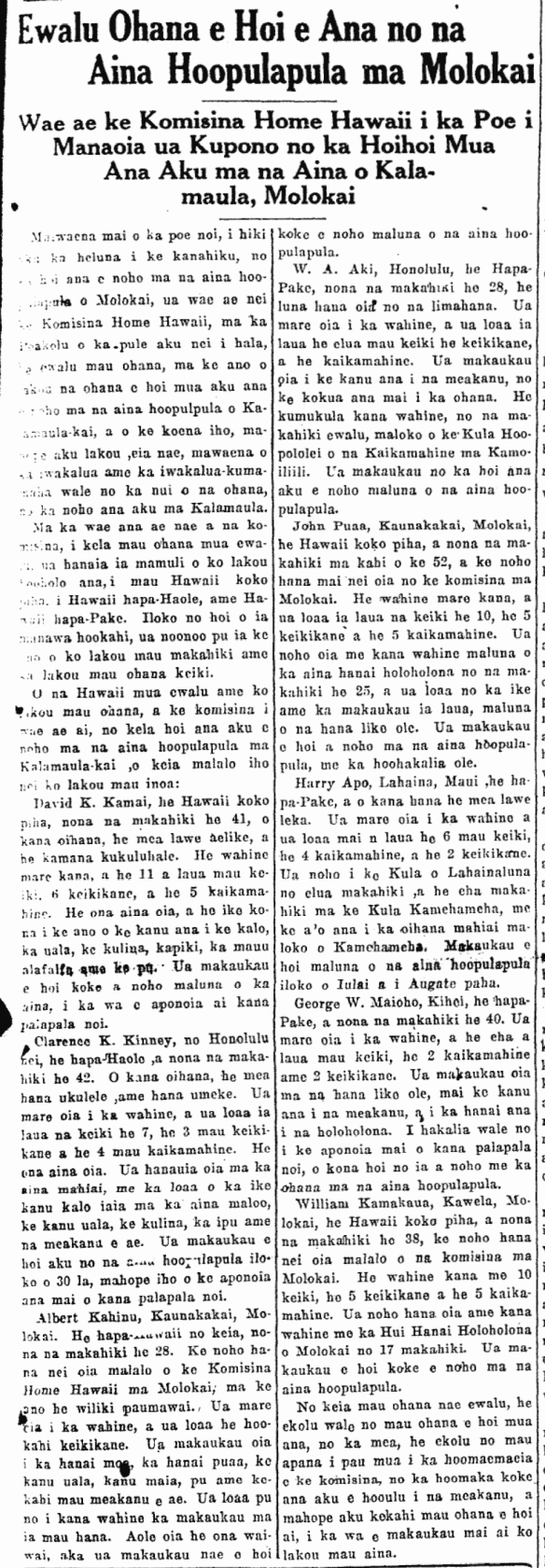Eleven More People Approved for Lands on Molokai
The Hawaiian Homes Commission Selects Once More People for Homestead Lands on Molokai at the Meeting on this Past Tuesday
At the meeting of the Hawaiian Homes Commission on the afternoon of this past Tuesday, the commission selected eleven more people from amongst the many who applied to return to the homestead lands [aina hoopulapula] on Molokai; and added to the eight who the commission previously selected, that makes twenty Hawaiian families total who will be the first to go back to the twenty parcels opened up in Kalamaula, Molokai.
There are three parcels left to be divided up by the commission for twenty families and one section is set aside by the commission as an area to grow plants as a sample, and there are two pieces of land left to be surveyed.
There were seventy-nine applications submitted to the commission by Hawaiians, to return to homestead lands on Molokai, abut from amongst this number, there were thirty applications denied by the commission for appropriate reasons as deemed by them, and as for the rest, they were all approved.
The people whose applications were approved by the commission in that meeting are these below:
ZACCHARY PALI PAHUPU, who is 47 years old, a full Hawaiian, whose wife is also full Hawaiian, and they have seven children. He is employed at the ranch on Molokai.
K. KEALA KUPIHEA, who is 46 years old, a full Hawaiian, and so is his wife, and they have four children. He is a supervisor at the California Packing Corporation [CPC] in Wahiawa, Oahu.
HARRY A. HANAKAHI, who is 40 years old, three-fourths blooded Hawaiian, along with his wife who is full-blooded Hawaiian, and their seven children. He is a carpenter for the Hawaiian Contracting Co.
HENRY H. WISE, is 40 years old, a hapa Hawaiian, as well as his wife, along with their seven children. He is a carpenter by trade, and is living in Waimea, Kauai.
MRS. REBECCA KEALOHA KAAHU, is 32 years old, a full Hawaiian, and her husband is a Hawaiian as well, and they have five children. They reside in Kaunakakai, Molokai.
FRANK Y. ASEU, is 25 years old, Chinese-Hawaiian, and he has a Hawaiian wife, with two children. He is employed at the press of the Star-Bulletin Newspaper.
MRS. DAVID KAAI, is a hapa Hawaiian, and she has a full-Hawaiian husband, and they have eight children. They live in Kaunakakai, Molokai.
MRS. MIRIAM KAPANA, is 30 years old, she is full Hawaiian, she has a Hawaiian husband, and they have four children. They live on Auld Lane in this town.
MARCELLUS DUDOIT, is 34 years old, a hapa Hawaiian, and his wife is full Hawaiian, and they have seven children. He is an engineer working under the Hawaiian Contracting Co.
DANIEL K. HIPA, is 29 years old, a full Hawaiian, and he has a full-Hawaiian wife, and they have four children. He is a second mate aboard the ship the Bee.
DAVID K. MARTIN, is 43 years old, he is seven-eighths Hawaiian, and he has a full-Hawaiian wife, and they have four children. He is a house builder, and they reside in Kaimuki.
During that meeting of the commission, a resolution was passed clarifying that those who live on the homesteads must live there permanently and not be allowed to move away from their land, except with approval from the commission with their promise that they will continue to farm and live on their land.
Put before the meeting of the commission were some terms of the lease drawn out by the attorney general and considerations of these were postponed until another time.
In the lease, it will specify the time when the person who applied must begin living on his land, that being within one year of his application being approved.
Another thing included in the lease is that it prohibits them from releasing out sections of their land to others; also, they are not to mortgage off their land, or do else wise other than what is approved of by the commission.
The secretary was instructed to send out letters to those whose applications were denied; as well as to those whose applications were approved but did not receive a parcel, asking them if they will leave their applications in until land is made available elsewhere on Molokai; and also to notify those who the commission selected that they will be put in a lottery [? komo ana iloko o ka helu] in the future when the homesteads open up.
(Kuokoa, 8/17/1922, p. 1)

Ka Nupepa Kuokoa, Buke LXI, Helu 33, Aoao 1. Augate 17, 1922.



